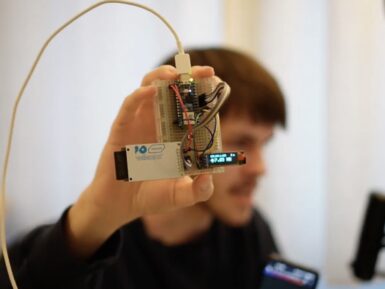
Arduino MKR IMU Shield
Need to integrate inertial measurements within your MKR based project? Plug in the Arduino MKR IMU shield and get the three-dimensional acceleration, yaw rate and magnetic field strength data in 3 perpendicular axes.
Overview
The MKR IMU Shield is based on the BNO055 absolute orientation sensor from Bosch Sensortec GmbH which integrates a triaxial 14-bit accelerometer, a triaxial 16-bit gyroscope with a range of ±2000 degrees per second and a triaxial geomagnetic sensor with a 32-bit microcontroller running the BSX3.0 FusionLib software. The sensor features three-dimensional acceleration, yaw rate and magnetic field strength data each in 3 perpendicular axes.
Tech specs
|
Sensor |
BNO055 from Bosch (product page) |
|
Operating voltage |
3.3V |
|
Extension interface |
4 pin header connector |
|
Communication protocol |
I2C |
|
Compatibility |
MKR Family |
Conformities
Resources for Safety and Products
Manufacturer Information
The production information includes the address and related details of the product manufacturer.
Arduino S.r.l.
Via Andrea Appiani, 25
Monza, MB, IT, 20900
https://www.arduino.cc/
Responsible Person in the EU
An EU-based economic operator who ensures the product's compliance with the required regulations.
Arduino S.r.l.
Via Andrea Appiani, 25
Monza, MB, IT, 20900
Phone: +39 0113157477
Email: support@arduino.cc
Documentation
OSH: Schematics
The Arduino MKR IMU Sheld is open-source hardware! You can build your own board using the following files:
EAGLE FILES IN .ZIP SCHEMATICS IN .PDFLearn more
Get Inspired

I have prepare home Automoation project using Arduino nano esp32

Home file servers can be very useful for people who work across multiple devices and want easy access to their documents. And there are a lot of DIY build guides out there. But most of them are full-fledged NAS (network-attached storage) devices and they tend to rely on single-board computers. Those take a long time to boot and consume quite a lot of power. This lightweight file server by Zombieschannel is different, because it runs entirely on an Arduino. An ESP32 is a microcontroller with built-in connectivity (Wi-Fi and Bluetooth). Like all MCUs, it can “boot” and start running its firmware almost instantly. And while it runs, it will consume much less power than a conventional PC or a single-board computer. Zombieschannel’s project proves that the Arduino Nano ESP32 is suitable for a file server — if your expectations are modest. The hardware for this project consists of a Nano ESP32, an SD card reader module, and a small monochrome OLED screen. The SD card provides file storage and the OLED shows status information. Most of the work went into writing the firmware, which Zombieschannel did with assistance from ChatGPT. That has the Arduino hosting a basic web interface that local users can access to upload or download files. Zombieschannel also created a command line interface that provides more comprehensive access via a serial connection. This does have limitations and the transfer speeds are quite slow by modern standards. But the file server seems useful for small files, like text documents. Zombieschannel plans to design an enclosure for the device and it should tuck unobtrusively into a corner, where it can run without drawing much power.








